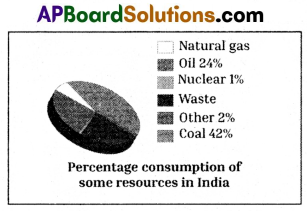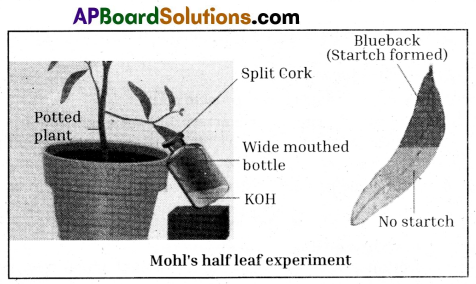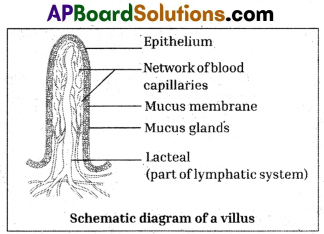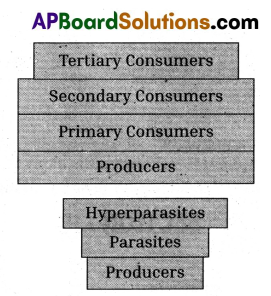Students must rely on TS 10th Class Biology Model Papers Set 8 to gauge their understanding of exam patterns.
TS 10th Class Biology Model Paper Set 8 with Solutions
Time: 1 Hour 30 minutes
Maximum Marks: 40
General Instructions:
- Read the question paper carefully and understand.
- Answer the questions under Part – A in the answer sheet provided.
- Part – A contains three sections : section – I, II and III.
- There is an internal choice to the questions under section – III.
- Part – B Answers should be written in the given brackets and attach to the Part – A answer sheet.
- Write the answers following the instructions given in each section.
Part – A (30 Marks)
Section – I (3 × 2 = 6M)
Instructions :
- This section contains 3 very short answer questions.
- Answer ALL the questions.
- Write answer to each question in 3 to 4 sentences.
- Each question carries 2 marks.
Question 1.
What is the relationship between number of stomata and rate of photosynthesis ?
Answer:
- The rate of photosynthesis is directly proportional to the number of stomata.
- The rate of photosynthesis increases with the increase in the number of stomata.
Question 2.
When will you get muscle cramps and why ?
Answer:
- The anaerobic respiration by muscles bring about partial breakdown of glucose to form lactic acid.
- The lactic acid accumulates in the muscles.
- This accumulation of lactic acid causes muscle pains.
![]()
Question 3.
Why should we measure B.P. in the upper arm artery ?
Answer:
- B.P. is always measured in the upper arm artery. B.P. varies throughout the body, so a standard place must be used so that a person’s blood pressure can be compared over a period of time.
- Doctors measure the blood pressure with a device called Sphygmomanometer.
Section – II (3 × 3 = 9M)
Instructions :
- This section contains 3 short answer questions.
- Answer ALL the questions.
- Write answer to each question in 5 to 6 sentences.
- Each question carries 3 marks.
Question 4.
Dileep is suffering from Diabetes. Doctor told to him pancreas is the reason for his diabetes. What type of questions he would ask to know about that ?
Answer:
- What is the relation between diabetes and pancreas ?
- How does the secretions from pancreas help to digest the food material ?
- What are the enzymes secreted by pancreas ?
- How are these secretions useful to prevent diabetes ?
Question 5.
What questions will you ask a paleontologist about fossils ?
Answer:
- How were fossils formed ?
- What are the uses of fossils ?
- Can we guess the life on the earth through fossils ?
- How are fossils taken out from Earth’s surface ?
- Are all the organisms formed as fossils ?
Question 6.
Draw a pie diagram showing percentage consumption of some resources in India.
Answer:

Section – III (3 × 5 = 15M)
Instructions :
- This section contains 3 essay type questions.
- Answer ALL the questions.
- There is an internal choice for each question.
- Write answer to each question in 8 to 10 sentences.
- Each question carries 5 marks.
Question 7.
How can you prove that carbondioxide is essential for plants ?
(OR)
What is transport system ? How this helps the organism ?
Answer:
Aim : To prove that carbondioxide is essential for photosynthesis by Mohl’s half leaf experiment.
Apparatus : A wide mouthed bottle, KOH solution, potted plant, vertically split cork, iodine solution.
Procedure :
- Arrange the apparatus as shown in the figure.
- Take the wide mouthed transparent bottle.
- Put potassium hydroxide pellets or KOH solution in the bottle. Potassium hydroxide absorbs carbondioxide.
- Insert splitted cork in the mouth of the bottle.
- Insert one of the leaves of destarched plant through a split cork into transparent bottle containing potassium hydroxide pellets / KOH solution.
- Leave the plant in sunlight.
- After a few hours, test this leaf of the plant for starch.
Observation : The leaf which was exposed to the atmospheric air becomes bluish black and the one inside the flask containing potassium hydroxide (KOH) which absorbs carbondioxide in the bottle does not become blue-black showing that carbondioxide is necessary for photosynthesis. Result: The experiment proves that CO2 is necessary for photosynthesis.
Precautions :
- The part of the leaf kept in KOH solution should not touch it.
- The apparatus should be kept air tight by applying grease or vaseline.

(OR)
- Transport is a life process in which a substance absorbed in one part of the body of an organism is carried to the other parts of its body.
- Transport system is present in the bodies of all organisms and they are essential to keep the cells alive and healthy. Failure of these transport system would result in diseases.
- This system which transports the materials from where they are produced and to the place where they are needed is called t ransport system.
- Cells of our body require various substances to live, grow and carry out their activities. So they should be supplied with food and substances such as amino acids, fatty acids, vitamins and minerals.
- Cells also require water. All the substances are derived from the food we eat and water we drink. To supply all these materials, we need a transport system.
- At the same time undigested materials should be removed from the digestive system.
- Oxygen is required for the food to be oxidized. Oxygen is taken into the lungs and from here it should be transported to every cell in the body. Carbondioxide produced during oxidation process should be collected and transported to the lungs for elimination.
- Several waste materials produced in the cells are to be collected and are transported to various sites in the body for disposal.
- hormones are the chemicals which control and co-ordinate the functions in the body. They are produced by endocrine glands present at different locations in the body and work at different places. Therefore hormones are to be transported.
![]()
Question 8.
Draw the neat diagram of meiosis.
(OR)
Explain any two natural and two artificial vegetative propagation methods to produce more number of plants in less time period with examples.
Answer:

(OR)
Two natural modes of vegetative propagation :
Leaves : In Bryophyllum small plants grow at the edges of leaves.
Stems : Aerial weak stems like runners and stolons, when they touch the ground, give off ad¬ventitious roots. When the connection with the parent plant is broken, the stem portion with adventitious roots develops into an independent plant.
Two artificial modes of vegetative propagation :
Cutting : Some plants can grow individually when a piece of the parent plant having bud is cut off from the existing plant. The lower part of this cutting is hurried in moist soil. After few days, the cut parts having buds grow as an individual plant after developing roots. E.g.: Rose, Hibiscus. Layering : A branch of the plant with at least one node is bent towards the ground and a part of it is covered with moist soil leaving the tip of the branch exposed above the ground. After a few days, new roots develop from the part of the branch hurried in the soil. E.g.: Nerium.
Question 9.
Draw a schematic diagram of villus in small intestine. Explain how digestive system co-ordinates with circulatory system.
(OR)
Write a short note on pyramid of number.
Answer:
- End products of digestion are finally absorbed in the walls of small intestine.
- From here digestive system needs co-ordination with circulatory system.
- Glucose moves into the cells of intestinal mucosa . pressured by diffusion and active transport.

(OR)
- Pyramid of number is a graphical representation designed to show the number of organisms at each trophic level in a given ecosystem.
- The shape of this pyramid varies from ecosystem to ecosystem.
- In aquatic and grassland ecosystems, numerous small autotrophs support lesser herbi¬vores which support further small number of carnivores and hence the pyramid structure is upright.
- In forest ecosystem, less number of producers support greater number of herbivores who in turn support a fewer number of carnivores. Hence the pyramid structure is partly upright.
- In parasitic food chain, one primary producer supports numerous parasites which support
still more hyperparasites. Hence the pyramid structure is inverted.

![]()
Part – B (10 Marks)
Instructions :
- Write the answers to the questions under Part – B on the question paper itself and attach it to the answer book of Part – A.
- Each question carries 1 mark.
- Marks will not be awarded in any case of overwriting, rewritten or erased answers.
- Write the capital letter (A / B / C / D) showing the correct answer for the following questions in the brackets provided against them.
Question 1.
Chemical formula of glucose is
A) C6H12O5
B) C6H12O6
C) C6H22O12
D) C6H10O5
Answer:
B) C6H12O6
Question 2.
Consider the following statements.
a) Vibration of vocal cords generate voice.
b) Exhaled air create vibrations at vocal cords.
A) Both a and b are true
B) a is true, b is false
C) a is false, b is true
D) Both a and b are false
Answer:
A) Both a and b are true
Question 3.
Which of the following is correct ?
1) CO2 is transported in the form of bicarbonate.
2) Some part of CO2 dissolves in Haemoglobin and some part in plasma.
3) Oxygen when carried to the blood it turns into oxy-haemoglobin.
4) The chlorophyll in blood plays a vital role in the transportation of CO2.
A) 1 and 2 only
B) 2, 3 and 4 only
C) 1, 2 and 3 only
D) 2 and 3 only
Answer:
C) 1, 2 and 3 only
Question 4.
Translocation of food and hormones is the main function of
A) Xylem
B) Phloem
C) Cambium
D) Stem
Answer:
B) Phloem
Question 5.
Papaver somniferum is the scientific name of
A) Morphine
B) Reserpine
C) Caffeine
D) Nimbin
Answer:
A) Morphine
![]()
Question 6.
Choose the correct sentence that concerns with kidneys
A) One pair of kidneys, one pair of ureters, urinary bladder
B) One pair of urinary bladder, one pair of ureters, kidney
C) One pair of kidneys, one pair of urinary bladder, ureter
D) One pair of ureters, one pair of kidneys, ureter
Answer:
A) One pair of kidneys, one pair of ureters, urinary bladder
Question 7.
By seeing the following picture, identify where does the tubular reabsorption occur.

A) Glumerulus
B) DCT
C) PCT
D) Bowman’s capsule
Answer:
C) PCT
Question 8.
Consider the statements a and b
a – Changes occur in muscles due to stimuli,
b – The change occurs in the speed of muscles leads to responses.
A) both a and b are true
B) a is true, b is false
C) a is false, b is true
D) both a and b are false
Answer:
B) a is true, b is false
Question 9.
1. Stolon,
2. Bulbs,
3. Corns.
Pick out the right option for the above methods of Vegetative propagation.
a) Vallisnaria
b) Onion
c) Potato
d) Turmeric
A) 1 – a, 2 – b, 3 – c
B) 1 – b, 2 – a, 3 – d
C) 2 – b, 3 – c, 1 – a
D) 1 – a, 2 – b, 3 – d
Answer:
D) 1 – a, 2 – b, 3 – d
Question 10.
STD stands for
A) Subscribers Trunk Demand
B) Sexually Trunk Dialing
C) Sexually Transmitted Diseases
D) Sexually Telephoned Dialing
Answer:
C) Sexually Transmitted Diseases